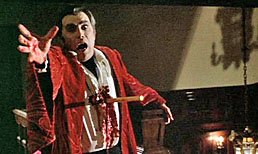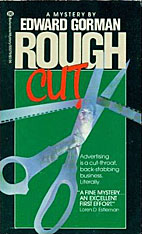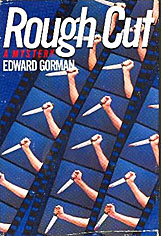Subtitled: “The Dave Brubeck Quartet Plays Cole Porter.” I thought I knew all of Brubeck’s early LP’s, but I just came across this one for the first time. It’s available on CD only as a Japanese import.
November 2016
Fri 18 Nov 2016
Music I’m Listening To: DAVE BRUBECK “Anything Goes!” [Complete LP].
Posted by Steve under Music I'm Listening To[5] Comments
Thu 17 Nov 2016
A Belated Halloween Movie Review: COUNT YORGA, VAMPIRE (1970).
Posted by Steve under Horror movies , Reviews[6] Comments
COUNT YORGA, VAMPIRE. American International Pictures, 1970. Alternative title: The Loves of Count Iorga, Vampire. Robert Quarry (Count Yorga), Roger Perry, Michael Murphy, Michael Macready, Donna Anders, Judy Lang. Narrator: George Macready. Screenwriter-Director: Bob Kelljan.
We first meet Count Yorga as he is conducting a seance attended by six couples in modern day (1970s) Los Angeles, as they try to contact the deceased mother of one of the young women in the party. Several of those attending do think it is a party, making jokes and general fun of the proceedings. They shouldn’t have.
After the seance, one of the couples takes the Count, a recent arrival from Bulgaria, home to what looks like a veritable castle somewhere in the Hollywood Hills. They have trouble leaving and have to stay the night stranded on the castle grounds in their Volkswagen bus, unknowingly allowing a strange visitor enter while they are sleeping.

Matters progress very well from these, at least from Count Yorga’s perspective. The others investigate, even to the extent of calling in a doctor who is an expert in blood disorders. It slowly dawns on them who (or what) they are dealing with. A direct confrontation is in order, and and from the viewer’s perspective, it proves most amusing as well as chilling.
And this is the effect of the entire movie, which when it started out was intended to be a soft-core pornography film, a few hints of which still remain. This may be one of the first vampire films to take place in a modern day setting, and in spite of its low budget, it manages to take good advantage of that fact very well. The ending, by the way, is one well worth waiting for.
Thu 17 Nov 2016
Mystery Review: JOANNE DOBSON – The Maltese Manuscript.
Posted by Steve under Bibliographies, Lists & Checklists , Characters , Reviews[7] Comments
JOANNE DOBSON – The Maltese Manuscript. Poisoned Pen Press, hardcover, 2003; softcover, 2006. ibooks, mass market paperback, May 2004.
I haven’t been reading the recent crop of cozy mysteries very much any more. They’ve become too soft and fluffy for me. Too much giddy character interplay, too much emphasis on hobbies, quilting or cooking, and worst of all, too little puzzle or mystery. They’re meant for female readers who can’t get enough of them, not for men who want hardboiled PI stories or old folks like me who want real detective work and/or surprise twists in their tales. So I pass them by, and have been for quite a while.
With exceptions. While this one may not be recent, it is a cozy by nature, being one of a series of mystery adventures had by a Women’s Studies professor at a small elite college in a fictionalized version of the Amherst MA area. What it does have is a gimmick encapsulated in the title that caught my immediate attention anyway, as it may have already snagged yours as well.
Part of the detective fiction holdings at Enfield College is the original manuscript of The Maltese Falcon, annotated and corrected in Hammett’s own hand. Valuable? I’d say so, if it existed. (Does it?) But when it disappears during a crime fiction conference at the school, the dean wants the incident hushed up. Who’d donate to any library that has such poor security in place?
Karen Pelletier is the professor referred to in paragraph two, and with the assistance of mystery writer Sunnye Hardcastle, creator of he extremely popular PI Kit Danger books, plunges right into solving both the theft of the manuscript and more, the mysterious death of a nighttime intruder in the underground stacks of the school’s library.
Complicating matters is that Karen’s boy friend is Lt. Charlie Pietrowski of the local police force, who doesn’t want her butting in, and a PI named Dennis O’Hanlon whom Karen meets up with again at a high school reunion, and coincidence be damned, he has just been hired by the dean to worr undercover while investigating the theft. That Karen is attracted to him causes some problems, wouldn’t you know?
After some slow going in the first 80 or pages, the book takes off at last, as the investigation finally begins. There is a lot of witty and wry commentary on the academic approach to deconstructing mystery fiction along the way, and a book thief’s storage houses for the thousands and thousands of the valuable first edition mystery hardcovers he’s stolen from libraries all across the country would be a sight to behold, if it ever existed.
A minor work, when all’s said and done, but it’s still fun while it lasts. And as a final postscript, let me add that the quoted portions of Sunnye Hardcastle’s novels are patently (and joyously) awful.
The Karen Pelletier series —
1. Quieter Than Sleep (1997)
2. The Northbury Papers (1998)
3. The Raven and the Nightingale (1999)
4. Cold and Pure and Very Dead (2000)
5. The Maltese Manuscript (2003)
6. Death Without Tenure (2010)
Thu 17 Nov 2016
Music I’m Listening To: CLEA BRADFORD “Summertime.”
Posted by Steve under Music I'm Listening To[3] Comments
From this American blues, soul and jazz singer’s 1968 LP, Her Point of View.
Wed 16 Nov 2016
EDWARD GORMAN – Rough Cut. St. Martin’s Press, hardcover, 1985. Ballantine, paperback, August 1986.

The late Ed Gorman was such a towering figure in the world of mystery fiction, it came as a surprise when I realized that this, his first novel, was published only 30 years ago. If you’d have asked me, I’d have said that I’d known his name much, much longer than that. As a writer and editor and (for example) the first publisher of Mystery Scene, among other accomplishments, many of them behind the scenes, he was a man who will be missed.
And he was a writer with a distinctive edge, from the very first book. Most sources list Rough Cut as the first in his series of PI Jack Dwyer novels, but it is not so. There is a PI in this book, but it is a poor shnook named Harold Stokes, a nebbish kind of guy whose loyalty to a client is slimmer than a two dollar bill, viewed sideways.
No, the protagonist in Rough Cut is the head of an ad agency in the greater Chicago area named Michael Ketchum, whose partner is found stabbed in his own home. Gorman, being an adman himself before switching careers relatively late in life, obviously wrote his first book based on a world he knew full well.

Investigating on his own, and lying to the police about an alibi that isn’t so, Ketchum finds that his office had been filled with more than the usual small spats and petty hatreds: apparently everybody has been sleeping with everyone else, for example. Even the accountant’s secretary-mistress was cheating on him with someone else.
Or in other words, there is a dark-tinged noir feeling to Ketchum’s self-imposed attempt to identify the killer, hopefully not his company’s most affluent client, before the police do. It is incumbent on him to do so to protect the firm, to save the jobs of so many people, not to mention the support he has to provide to his two kids and to a father with Alzheimer’s. The weight of the world is on his shoulders, and in quiet desperation, he knows it.
This is a no-frills tale that’s tersely told, and is all the more effective for it — only 150 pages long in the paperback edition. A very good start, in my opinion, to a long and productive career — but not long enough.
Wed 16 Nov 2016
Reviewed by William F. Deeck: R. C. WOODTHORPE – Rope for a Convict.
Posted by Steve under ReviewsNo Comments
William F. Deeck
R. C. WOODTHORPE – Rope for a Convict. Doubleday Crime Club, hardcover, 1940. First published in the UK by Nicholson, hardcover, 1939.
Willie Hopper, movie director, has come to Dartmoor and movie star Daisy Nightingale’s cottage to begin filming a movie based on an escape from Dartmoor Prison. At the same time, an actual prisoner has escaped from Dartmoor. Nightingale’s young son, Malcolm, aids the escape, as does another person, thought the latter’s motives are not as disinterested as Malcolm’s. Then murder occurs, and the escaped prisoner is accused of it as well as the theft of a Shakespeare First Folio signed by Ben Jonson.
No detection here, coincidences abound and perplex, and more could have been done from the movie angle. But the characters are interesting and often amusing — the curate definitely should have been given a greater role — and Woodthorpe is a first class stylist. Pleasant reading.
Bibliographic Notes: R(alph) C(arter) Woodthorpe was the author of eight British crime novels; four of them were reprinted in the US by Doubleday. Two of the books feature a character named Nicholas Slade; Matilda Perks appears in another two. At the moment, away from Ellen Nehr’s complete compendium of the Crime Club novels, I know nothing about either of the two.
Wed 16 Nov 2016
Music I’m Listening To: JOAN JETT “Tulane.”
Posted by Steve under Music I'm Listening To[2] Comments
Tue 15 Nov 2016
A Sci-Fi Movie Review by Jonathan Lewis: EARTH VS. THE FLYING SAUCERS (1956).
Posted by Steve under Reviews , SF & Fantasy films[4] Comments
EARTH VS. THE FLYING SAUCERS. Columbia Pictures, 1956. Hugh Marlowe, Joan Taylor, Donald Curtis, Morris Ankrum. Screen story by Curt Siodmak, based on the book Flying Saucers from Outer Space, by Major Donald E. Keyhoe. Director: Fred F. Sears.
What would humanity do if UFOs waged war on Earth? Would a scientist invent a means of stopping those rascally aliens and then allow the U.S. military to utilize that technology? If you think that’s the most likely scenario, then Earth vs. the Flying Saucers will offer few surprises.
The plot follows rocket scientist Dr. Russell A. Marvin (Hugh Marlowe) and his new bride Carol (Joan Taylor) as they contend with an imminent alien invasion. Complicating matters is the fact that Carol’s father, Brig. Gen. John Hanley (Morris Ankrum), has been kidnapped by the interstellar humanoids and turned into a zombie! This leads Dr. Marvin to take the lead in discovering a way of repelling the forthcoming alien invasion. Upon learning how the UFOs operate, Marvin creates a sonic weapon that proves useful to the U.S. Army as they wage war on alien vessels attempting to conquer Washington.
If you think the plot sounds mildly intriguing – and I admit writing it made me realize how much potential the film had – you should realize that this particular science fiction movie is rather flat, both in terms of style and substance.
Indeed, if Earth vs. the Flying Saucers has an auteur, it is most certainly special effects guru Ray Harryhausen. Responsible for the film’s stellar stop-motion animation, Harryhausen’s skill in unleashing movie magic is evident throughout what is otherwise a rather dull, plodding 1950s science fiction feature.
Neither the direction nor the acting, save the welcome presence of character actor Morris Ankrum, is particularly memorable; in fact, much of it is truly forgettable. All of which serves to make Harryhausen’s contribution to the movie even more valuable, for without it, there’d honestly be no compelling reason to seek out this one out.
Tue 15 Nov 2016
Archived Review: MARGARET SCHERF – The Beaded Banana.
Posted by Steve under Bibliographies, Lists & Checklists , Characters , Reviews[8] Comments
MARGARET SCHERF – The Beaded Banana. Doubleday Crime Club, hardcover, 1978. No US paperback edition.
The title sounds like that of a second-rate rock group, but it’s actually the prized possession of a member of the fly-by-night movie company that’s shooting on location in Summerfield, Montana. An undesirable Las Vegas element is moving into town as well, and some unsavory political hi-jinx foreshadow some very strange things about to happen, including murder.
The detective is retired pathologist Dr. Grace Severance, and it’s no reflection on her to say that what we have here is a mystery full of flutsy old ladies doing their thing. The humor is of the quiet zinger type, which does a lot to mitigate all the conclusions that are so ungracefully leapt to along the way.
The Dr. Grace Severance series —
The Banker’s Bones. Doubleday, 1968.
The Beautiful Birthday Cake. Doubleday, 1971.
To Cache a Millionaire. Doubleday, 1972.
The Beaded Banana. Doubleday, 1978.
The Beaded Banana was Margaret Scherf’s final book. Between 1940 and 1978 she wrote a total of 24 works of detective fiction, including four in her Emily & Henry Bryce series, and seven more featuring Rev. Martin Buell. Many of her books also take place in Montana.
Tue 15 Nov 2016
Music I’m Listening To: RUTH COPELAND “I Am What I Am” [Full Album].
Posted by Steve under Music I'm Listening To[2] Comments
This British singer’s backup band on this 1971 album, her second, consisted largely of former Parliament-Funkadelic musicians.